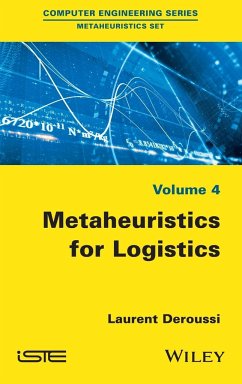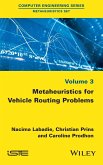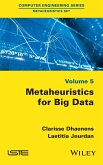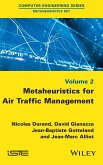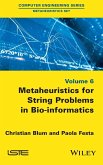Laurent Deroussi
Metaheuristics for Logistics
Laurent Deroussi
Metaheuristics for Logistics
- Gebundenes Buch
- Merkliste
- Auf die Merkliste
- Bewerten Bewerten
- Teilen
- Produkt teilen
- Produkterinnerung
- Produkterinnerung
This book describes the main classical combinatorial problems that can be encountered when designing a logistics network or driving a supply chain. It shows how these problems can be tackled by metaheuristics, both separately and using an integrated approach. A huge number of techniques, from the simplest to the most advanced ones, are given for helping the reader to implement efficient solutions that meet its needs. A lot of books have been written about metaheuristics (methods for solving hard optimization problems) and supply chain management (the field in which we find a huge number of…mehr
Andere Kunden interessierten sich auch für
![Metaheuristics for Vehicle Routing Problems Metaheuristics for Vehicle Routing Problems]() Nacima LabadieMetaheuristics for Vehicle Routing Problems194,99 €
Nacima LabadieMetaheuristics for Vehicle Routing Problems194,99 €![Metaheuristics for Intelligent Electrical Networks Metaheuristics for Intelligent Electrical Networks]() Frédéric HéliodoreMetaheuristics for Intelligent Electrical Networks194,99 €
Frédéric HéliodoreMetaheuristics for Intelligent Electrical Networks194,99 €![Metaheuristics for Robotics Metaheuristics for Robotics]() Hamouche OulhadjMetaheuristics for Robotics193,99 €
Hamouche OulhadjMetaheuristics for Robotics193,99 €![Metaheuristics for Big Data Metaheuristics for Big Data]() Clarisse DhaenensMetaheuristics for Big Data194,99 €
Clarisse DhaenensMetaheuristics for Big Data194,99 €![Metaheuristics for Air Traffic Management Metaheuristics for Air Traffic Management]() Nicolas DurandMetaheuristics for Air Traffic Management192,99 €
Nicolas DurandMetaheuristics for Air Traffic Management192,99 €![Metaheuristics for String Problems in Bio-Informatics Metaheuristics for String Problems in Bio-Informatics]() Christian BlumMetaheuristics for String Problems in Bio-Informatics189,99 €
Christian BlumMetaheuristics for String Problems in Bio-Informatics189,99 €![Metaheuristics for Enterprise Data Intelligence Metaheuristics for Enterprise Data Intelligence]() Metaheuristics for Enterprise Data Intelligence194,99 €
Metaheuristics for Enterprise Data Intelligence194,99 €-
-
-
This book describes the main classical combinatorial problems that can be encountered when designing a logistics network or driving a supply chain. It shows how these problems can be tackled by metaheuristics, both separately and using an integrated approach. A huge number of techniques, from the simplest to the most advanced ones, are given for helping the reader to implement efficient solutions that meet its needs. A lot of books have been written about metaheuristics (methods for solving hard optimization problems) and supply chain management (the field in which we find a huge number of combinatorial optimization problems) in the last decades. So, the main reason of this book is to describe how these methods can be implemented for this class of problems.
Hinweis: Dieser Artikel kann nur an eine deutsche Lieferadresse ausgeliefert werden.
Hinweis: Dieser Artikel kann nur an eine deutsche Lieferadresse ausgeliefert werden.
Produktdetails
- Produktdetails
- Verlag: Wiley
- Seitenzahl: 224
- Erscheinungstermin: 23. Februar 2016
- Englisch
- Abmessung: 240mm x 161mm x 17mm
- Gewicht: 504g
- ISBN-13: 9781848218086
- ISBN-10: 1848218087
- Artikelnr.: 42909367
- Herstellerkennzeichnung
- Libri GmbH
- Europaallee 1
- 36244 Bad Hersfeld
- gpsr@libri.de
- Verlag: Wiley
- Seitenzahl: 224
- Erscheinungstermin: 23. Februar 2016
- Englisch
- Abmessung: 240mm x 161mm x 17mm
- Gewicht: 504g
- ISBN-13: 9781848218086
- ISBN-10: 1848218087
- Artikelnr.: 42909367
- Herstellerkennzeichnung
- Libri GmbH
- Europaallee 1
- 36244 Bad Hersfeld
- gpsr@libri.de
Laurent Deroussi, Associate professor at the Blaise Pascal University of Clermont-Ferrand, France.
Introduction xi
Part 1. Basic Notions 1
Chapter 1. Introductory Problems 3
1.1. The "swing states" problem 3
1.2. Adel and his camels 5
1.3. Sauron's forges 7
1.3.1. Problem 1: The inspection of the forges 8
1.3.2. Problem 2: The production of the deadly weapon 9
Chapter 2. A Review of Logistic Problems 13
2.1. Some history 13
2.1.1. The Fermat-Torricelli point 13
2.1.2. The Monge problem 14
2.1.3. The Seven Bridges of Königsberg and the Icosian Game 15
2.2. Some polynomial problems 16
2.2.1. The assignment problem 16
2.2.2. The transportation problem 17
2.2.3. The Minimum-Cost Spanning Tree problem 19
2.3. Packing problems 20
2.3.1. The knapsack problem 20
2.3.2. The bin packing problem 21
2.4. Routing problems 22
2.4.1. The traveling salesman problem 23
2.4.2. The vehicle routing problem (VRP) 24
2.5. Production scheduling problems 24
2.5.1. The flow-shop scheduling problem (FSSP)26
2.5.2. The job-shop scheduling problem (JSSP) 29
2.6. Lot-sizing problems 31
2.7. Facility location problems 33
2.7.1. The Uncapacitated Plant Location Problem (UPLP) 33
2.7.2. The Dynamic Location Problem (DLP) 35
2.8. Conclusion 36
Chapter 3. An Introduction to Metaheuristics 37
3.1. Optimization problems 37
3.2. Metaheuristics: basic notions 39
3.2.1. Intensification and diversification 40
3.2.2. Neighborhood systems 40
3.3. Individual-based metaheuristics 41
3.3.1. Local search 41
3.3.2. Simulated annealing 44
3.3.3. The kangaroo Algorithm 46
3.3.4. Iterated local search 48
3.3.5. Tabu Search 49
3.4. Population-based metaheuristics 50
3.4.1. Evolutionary algorithms 51
3.4.2. The ant colony algorithm 52
3.4.3. Particle Swarm Optimization 53
3.5. Conclusion 55
Chapter 4. A First Implementation of Metaheuristics 57
4.1. Representing a list of objects 57
4.2. The implementation of a local search 59
4.2.1. The construction of an initial solution 59
4.2.2. Description of basic moves 60
4.2.3. The implementation of stochastic descent (LS) 62
4.3. The implementation of individual-based metaheuristics 64
4.3.1. Simulated annealing (SA) 64
4.3.2. Iterated local search (ILS) 66
4.14. Conclusion 66
Part 2. Advanced Notions 69
Chapter 5. The Traveling Salesman Problem 71
5.1. Representing a solution: the two-level tree structure 71
5.2. Constructing initial solutions 74
5.2.1. A greedy heuristic: nearest neighbor 74
5.2.2. A simplification heuristic: the Christofides algorithm 76
5.3. Neighborhood systems 78
5.3.1. The Lin & Kernighan neighborhood 79
5.3.2. Ejection chain techniques 83
5.4. Some results 86
5.5. Conclusion 88
Chapter 6. The Flow-Shop Problem 89
6.1. Representation and assessment of a solution 89
6.2. Construction of the initial solution 90
6.2.1. Simplification heuristics: CDS 91
6.2.2. A greedy heuristic: NEH 94
6.3. Neighborhood systems 97
6.3.1. Improvement of the insertion movements 98
6.3.2. Variable-depth neighborhood search 101
6.4. Results 107
6.5. Conclusion 107
Chapter 7. Some Elements for Other Logistic Problems 109
7.1. Direct representation versus indirect representation 109
7.2. Conditioning problems 111
7.2.1. The knapsack problem 111
7.2.2. The bin-packing problem 112
7.3. Lot-sizing problems 114
7.4. Localization problems 115
7.5. Conclusion 117
Part 3. Evolutions and Current Trends 119
Chapter 8. Supply Chain Management 121
8.1. Introduction to supply chain management 121
8.2. Horizontal synchronization of the supply chain 122
8.2.1. The beer game 123
8.2.2. The bullwhip effect 125
8.3. Vertical synchronization of a supply chain 126
8.4. An integral approach of the supply chain 127
8.5. Conclusion 129
Chapter 9. Hybridization and Coupling Using Metaheuristics 131
9.1. Metaheuristics for the optimization of the supply chain 131
9.2. Hybridization of optimization methods 133
9.2.1. Classification of hybrid methods 133
9.2.2. Illustration by example 134
9.2.3. "Metaheuristic/local search" hybridization 135
9.2.4. Metaheuristic hybridization/Exact Methods 135
9.3. Coupling of optimization methods and performance evaluations 138
9.3.1. Double complexity 138
9.3.2. Coupling of optimization method/simulation model 139
9.4. Conclusion 141
Chapter 10. Flexible Manufacturing Systems 143
10.1. Introduction to the FMS challenges 143
10.2. The job-shop problem with transport 145
10.2.1. Definition of the problem 145
10.3. Proposal for a metaheuristic/simulation coupling 148
10.3.1. Representation of a solution 148
10.3.2. Simulation method 149
10.3.3. Optimization method 152
10.3.4. Results 153
10.4. Workshop layout problem 154
10.4.1. Aggregated model and exact resolution 154
10.4.2. Detailed model and approximate solutions 157
10.5. Conclusion 159
Chapter 11. Synchronization Problems Based on Vehicle Routings 161
11.1. Inventory routing problem 162
11.1.1. Presentation of the problem 162
11.1.2. Resolution by metaheuristics 166
11.2. The location-routing problem 167
11.2.1. Definition of the problem 167
11.2.2. Solution with metaheuristics 171
11.3. Conclusion 172
Chapter 12. Solution to Problems 173
12.1. The swing state problem 173
12.2. Adel and his camels 176
12.2.1. First question 176
12.2.2. Second question 177
12.2.3. Third question 180
12.3. The forges of Sauron 180
12.3.1. The inspection of the forges 180
12.3.2. Production of the lethal weapon 183
Conclusion 185
Bibliography 187
Index 197
Part 1. Basic Notions 1
Chapter 1. Introductory Problems 3
1.1. The "swing states" problem 3
1.2. Adel and his camels 5
1.3. Sauron's forges 7
1.3.1. Problem 1: The inspection of the forges 8
1.3.2. Problem 2: The production of the deadly weapon 9
Chapter 2. A Review of Logistic Problems 13
2.1. Some history 13
2.1.1. The Fermat-Torricelli point 13
2.1.2. The Monge problem 14
2.1.3. The Seven Bridges of Königsberg and the Icosian Game 15
2.2. Some polynomial problems 16
2.2.1. The assignment problem 16
2.2.2. The transportation problem 17
2.2.3. The Minimum-Cost Spanning Tree problem 19
2.3. Packing problems 20
2.3.1. The knapsack problem 20
2.3.2. The bin packing problem 21
2.4. Routing problems 22
2.4.1. The traveling salesman problem 23
2.4.2. The vehicle routing problem (VRP) 24
2.5. Production scheduling problems 24
2.5.1. The flow-shop scheduling problem (FSSP)26
2.5.2. The job-shop scheduling problem (JSSP) 29
2.6. Lot-sizing problems 31
2.7. Facility location problems 33
2.7.1. The Uncapacitated Plant Location Problem (UPLP) 33
2.7.2. The Dynamic Location Problem (DLP) 35
2.8. Conclusion 36
Chapter 3. An Introduction to Metaheuristics 37
3.1. Optimization problems 37
3.2. Metaheuristics: basic notions 39
3.2.1. Intensification and diversification 40
3.2.2. Neighborhood systems 40
3.3. Individual-based metaheuristics 41
3.3.1. Local search 41
3.3.2. Simulated annealing 44
3.3.3. The kangaroo Algorithm 46
3.3.4. Iterated local search 48
3.3.5. Tabu Search 49
3.4. Population-based metaheuristics 50
3.4.1. Evolutionary algorithms 51
3.4.2. The ant colony algorithm 52
3.4.3. Particle Swarm Optimization 53
3.5. Conclusion 55
Chapter 4. A First Implementation of Metaheuristics 57
4.1. Representing a list of objects 57
4.2. The implementation of a local search 59
4.2.1. The construction of an initial solution 59
4.2.2. Description of basic moves 60
4.2.3. The implementation of stochastic descent (LS) 62
4.3. The implementation of individual-based metaheuristics 64
4.3.1. Simulated annealing (SA) 64
4.3.2. Iterated local search (ILS) 66
4.14. Conclusion 66
Part 2. Advanced Notions 69
Chapter 5. The Traveling Salesman Problem 71
5.1. Representing a solution: the two-level tree structure 71
5.2. Constructing initial solutions 74
5.2.1. A greedy heuristic: nearest neighbor 74
5.2.2. A simplification heuristic: the Christofides algorithm 76
5.3. Neighborhood systems 78
5.3.1. The Lin & Kernighan neighborhood 79
5.3.2. Ejection chain techniques 83
5.4. Some results 86
5.5. Conclusion 88
Chapter 6. The Flow-Shop Problem 89
6.1. Representation and assessment of a solution 89
6.2. Construction of the initial solution 90
6.2.1. Simplification heuristics: CDS 91
6.2.2. A greedy heuristic: NEH 94
6.3. Neighborhood systems 97
6.3.1. Improvement of the insertion movements 98
6.3.2. Variable-depth neighborhood search 101
6.4. Results 107
6.5. Conclusion 107
Chapter 7. Some Elements for Other Logistic Problems 109
7.1. Direct representation versus indirect representation 109
7.2. Conditioning problems 111
7.2.1. The knapsack problem 111
7.2.2. The bin-packing problem 112
7.3. Lot-sizing problems 114
7.4. Localization problems 115
7.5. Conclusion 117
Part 3. Evolutions and Current Trends 119
Chapter 8. Supply Chain Management 121
8.1. Introduction to supply chain management 121
8.2. Horizontal synchronization of the supply chain 122
8.2.1. The beer game 123
8.2.2. The bullwhip effect 125
8.3. Vertical synchronization of a supply chain 126
8.4. An integral approach of the supply chain 127
8.5. Conclusion 129
Chapter 9. Hybridization and Coupling Using Metaheuristics 131
9.1. Metaheuristics for the optimization of the supply chain 131
9.2. Hybridization of optimization methods 133
9.2.1. Classification of hybrid methods 133
9.2.2. Illustration by example 134
9.2.3. "Metaheuristic/local search" hybridization 135
9.2.4. Metaheuristic hybridization/Exact Methods 135
9.3. Coupling of optimization methods and performance evaluations 138
9.3.1. Double complexity 138
9.3.2. Coupling of optimization method/simulation model 139
9.4. Conclusion 141
Chapter 10. Flexible Manufacturing Systems 143
10.1. Introduction to the FMS challenges 143
10.2. The job-shop problem with transport 145
10.2.1. Definition of the problem 145
10.3. Proposal for a metaheuristic/simulation coupling 148
10.3.1. Representation of a solution 148
10.3.2. Simulation method 149
10.3.3. Optimization method 152
10.3.4. Results 153
10.4. Workshop layout problem 154
10.4.1. Aggregated model and exact resolution 154
10.4.2. Detailed model and approximate solutions 157
10.5. Conclusion 159
Chapter 11. Synchronization Problems Based on Vehicle Routings 161
11.1. Inventory routing problem 162
11.1.1. Presentation of the problem 162
11.1.2. Resolution by metaheuristics 166
11.2. The location-routing problem 167
11.2.1. Definition of the problem 167
11.2.2. Solution with metaheuristics 171
11.3. Conclusion 172
Chapter 12. Solution to Problems 173
12.1. The swing state problem 173
12.2. Adel and his camels 176
12.2.1. First question 176
12.2.2. Second question 177
12.2.3. Third question 180
12.3. The forges of Sauron 180
12.3.1. The inspection of the forges 180
12.3.2. Production of the lethal weapon 183
Conclusion 185
Bibliography 187
Index 197
Introduction xi
Part 1. Basic Notions 1
Chapter 1. Introductory Problems 3
1.1. The "swing states" problem 3
1.2. Adel and his camels 5
1.3. Sauron's forges 7
1.3.1. Problem 1: The inspection of the forges 8
1.3.2. Problem 2: The production of the deadly weapon 9
Chapter 2. A Review of Logistic Problems 13
2.1. Some history 13
2.1.1. The Fermat-Torricelli point 13
2.1.2. The Monge problem 14
2.1.3. The Seven Bridges of Königsberg and the Icosian Game 15
2.2. Some polynomial problems 16
2.2.1. The assignment problem 16
2.2.2. The transportation problem 17
2.2.3. The Minimum-Cost Spanning Tree problem 19
2.3. Packing problems 20
2.3.1. The knapsack problem 20
2.3.2. The bin packing problem 21
2.4. Routing problems 22
2.4.1. The traveling salesman problem 23
2.4.2. The vehicle routing problem (VRP) 24
2.5. Production scheduling problems 24
2.5.1. The flow-shop scheduling problem (FSSP)26
2.5.2. The job-shop scheduling problem (JSSP) 29
2.6. Lot-sizing problems 31
2.7. Facility location problems 33
2.7.1. The Uncapacitated Plant Location Problem (UPLP) 33
2.7.2. The Dynamic Location Problem (DLP) 35
2.8. Conclusion 36
Chapter 3. An Introduction to Metaheuristics 37
3.1. Optimization problems 37
3.2. Metaheuristics: basic notions 39
3.2.1. Intensification and diversification 40
3.2.2. Neighborhood systems 40
3.3. Individual-based metaheuristics 41
3.3.1. Local search 41
3.3.2. Simulated annealing 44
3.3.3. The kangaroo Algorithm 46
3.3.4. Iterated local search 48
3.3.5. Tabu Search 49
3.4. Population-based metaheuristics 50
3.4.1. Evolutionary algorithms 51
3.4.2. The ant colony algorithm 52
3.4.3. Particle Swarm Optimization 53
3.5. Conclusion 55
Chapter 4. A First Implementation of Metaheuristics 57
4.1. Representing a list of objects 57
4.2. The implementation of a local search 59
4.2.1. The construction of an initial solution 59
4.2.2. Description of basic moves 60
4.2.3. The implementation of stochastic descent (LS) 62
4.3. The implementation of individual-based metaheuristics 64
4.3.1. Simulated annealing (SA) 64
4.3.2. Iterated local search (ILS) 66
4.14. Conclusion 66
Part 2. Advanced Notions 69
Chapter 5. The Traveling Salesman Problem 71
5.1. Representing a solution: the two-level tree structure 71
5.2. Constructing initial solutions 74
5.2.1. A greedy heuristic: nearest neighbor 74
5.2.2. A simplification heuristic: the Christofides algorithm 76
5.3. Neighborhood systems 78
5.3.1. The Lin & Kernighan neighborhood 79
5.3.2. Ejection chain techniques 83
5.4. Some results 86
5.5. Conclusion 88
Chapter 6. The Flow-Shop Problem 89
6.1. Representation and assessment of a solution 89
6.2. Construction of the initial solution 90
6.2.1. Simplification heuristics: CDS 91
6.2.2. A greedy heuristic: NEH 94
6.3. Neighborhood systems 97
6.3.1. Improvement of the insertion movements 98
6.3.2. Variable-depth neighborhood search 101
6.4. Results 107
6.5. Conclusion 107
Chapter 7. Some Elements for Other Logistic Problems 109
7.1. Direct representation versus indirect representation 109
7.2. Conditioning problems 111
7.2.1. The knapsack problem 111
7.2.2. The bin-packing problem 112
7.3. Lot-sizing problems 114
7.4. Localization problems 115
7.5. Conclusion 117
Part 3. Evolutions and Current Trends 119
Chapter 8. Supply Chain Management 121
8.1. Introduction to supply chain management 121
8.2. Horizontal synchronization of the supply chain 122
8.2.1. The beer game 123
8.2.2. The bullwhip effect 125
8.3. Vertical synchronization of a supply chain 126
8.4. An integral approach of the supply chain 127
8.5. Conclusion 129
Chapter 9. Hybridization and Coupling Using Metaheuristics 131
9.1. Metaheuristics for the optimization of the supply chain 131
9.2. Hybridization of optimization methods 133
9.2.1. Classification of hybrid methods 133
9.2.2. Illustration by example 134
9.2.3. "Metaheuristic/local search" hybridization 135
9.2.4. Metaheuristic hybridization/Exact Methods 135
9.3. Coupling of optimization methods and performance evaluations 138
9.3.1. Double complexity 138
9.3.2. Coupling of optimization method/simulation model 139
9.4. Conclusion 141
Chapter 10. Flexible Manufacturing Systems 143
10.1. Introduction to the FMS challenges 143
10.2. The job-shop problem with transport 145
10.2.1. Definition of the problem 145
10.3. Proposal for a metaheuristic/simulation coupling 148
10.3.1. Representation of a solution 148
10.3.2. Simulation method 149
10.3.3. Optimization method 152
10.3.4. Results 153
10.4. Workshop layout problem 154
10.4.1. Aggregated model and exact resolution 154
10.4.2. Detailed model and approximate solutions 157
10.5. Conclusion 159
Chapter 11. Synchronization Problems Based on Vehicle Routings 161
11.1. Inventory routing problem 162
11.1.1. Presentation of the problem 162
11.1.2. Resolution by metaheuristics 166
11.2. The location-routing problem 167
11.2.1. Definition of the problem 167
11.2.2. Solution with metaheuristics 171
11.3. Conclusion 172
Chapter 12. Solution to Problems 173
12.1. The swing state problem 173
12.2. Adel and his camels 176
12.2.1. First question 176
12.2.2. Second question 177
12.2.3. Third question 180
12.3. The forges of Sauron 180
12.3.1. The inspection of the forges 180
12.3.2. Production of the lethal weapon 183
Conclusion 185
Bibliography 187
Index 197
Part 1. Basic Notions 1
Chapter 1. Introductory Problems 3
1.1. The "swing states" problem 3
1.2. Adel and his camels 5
1.3. Sauron's forges 7
1.3.1. Problem 1: The inspection of the forges 8
1.3.2. Problem 2: The production of the deadly weapon 9
Chapter 2. A Review of Logistic Problems 13
2.1. Some history 13
2.1.1. The Fermat-Torricelli point 13
2.1.2. The Monge problem 14
2.1.3. The Seven Bridges of Königsberg and the Icosian Game 15
2.2. Some polynomial problems 16
2.2.1. The assignment problem 16
2.2.2. The transportation problem 17
2.2.3. The Minimum-Cost Spanning Tree problem 19
2.3. Packing problems 20
2.3.1. The knapsack problem 20
2.3.2. The bin packing problem 21
2.4. Routing problems 22
2.4.1. The traveling salesman problem 23
2.4.2. The vehicle routing problem (VRP) 24
2.5. Production scheduling problems 24
2.5.1. The flow-shop scheduling problem (FSSP)26
2.5.2. The job-shop scheduling problem (JSSP) 29
2.6. Lot-sizing problems 31
2.7. Facility location problems 33
2.7.1. The Uncapacitated Plant Location Problem (UPLP) 33
2.7.2. The Dynamic Location Problem (DLP) 35
2.8. Conclusion 36
Chapter 3. An Introduction to Metaheuristics 37
3.1. Optimization problems 37
3.2. Metaheuristics: basic notions 39
3.2.1. Intensification and diversification 40
3.2.2. Neighborhood systems 40
3.3. Individual-based metaheuristics 41
3.3.1. Local search 41
3.3.2. Simulated annealing 44
3.3.3. The kangaroo Algorithm 46
3.3.4. Iterated local search 48
3.3.5. Tabu Search 49
3.4. Population-based metaheuristics 50
3.4.1. Evolutionary algorithms 51
3.4.2. The ant colony algorithm 52
3.4.3. Particle Swarm Optimization 53
3.5. Conclusion 55
Chapter 4. A First Implementation of Metaheuristics 57
4.1. Representing a list of objects 57
4.2. The implementation of a local search 59
4.2.1. The construction of an initial solution 59
4.2.2. Description of basic moves 60
4.2.3. The implementation of stochastic descent (LS) 62
4.3. The implementation of individual-based metaheuristics 64
4.3.1. Simulated annealing (SA) 64
4.3.2. Iterated local search (ILS) 66
4.14. Conclusion 66
Part 2. Advanced Notions 69
Chapter 5. The Traveling Salesman Problem 71
5.1. Representing a solution: the two-level tree structure 71
5.2. Constructing initial solutions 74
5.2.1. A greedy heuristic: nearest neighbor 74
5.2.2. A simplification heuristic: the Christofides algorithm 76
5.3. Neighborhood systems 78
5.3.1. The Lin & Kernighan neighborhood 79
5.3.2. Ejection chain techniques 83
5.4. Some results 86
5.5. Conclusion 88
Chapter 6. The Flow-Shop Problem 89
6.1. Representation and assessment of a solution 89
6.2. Construction of the initial solution 90
6.2.1. Simplification heuristics: CDS 91
6.2.2. A greedy heuristic: NEH 94
6.3. Neighborhood systems 97
6.3.1. Improvement of the insertion movements 98
6.3.2. Variable-depth neighborhood search 101
6.4. Results 107
6.5. Conclusion 107
Chapter 7. Some Elements for Other Logistic Problems 109
7.1. Direct representation versus indirect representation 109
7.2. Conditioning problems 111
7.2.1. The knapsack problem 111
7.2.2. The bin-packing problem 112
7.3. Lot-sizing problems 114
7.4. Localization problems 115
7.5. Conclusion 117
Part 3. Evolutions and Current Trends 119
Chapter 8. Supply Chain Management 121
8.1. Introduction to supply chain management 121
8.2. Horizontal synchronization of the supply chain 122
8.2.1. The beer game 123
8.2.2. The bullwhip effect 125
8.3. Vertical synchronization of a supply chain 126
8.4. An integral approach of the supply chain 127
8.5. Conclusion 129
Chapter 9. Hybridization and Coupling Using Metaheuristics 131
9.1. Metaheuristics for the optimization of the supply chain 131
9.2. Hybridization of optimization methods 133
9.2.1. Classification of hybrid methods 133
9.2.2. Illustration by example 134
9.2.3. "Metaheuristic/local search" hybridization 135
9.2.4. Metaheuristic hybridization/Exact Methods 135
9.3. Coupling of optimization methods and performance evaluations 138
9.3.1. Double complexity 138
9.3.2. Coupling of optimization method/simulation model 139
9.4. Conclusion 141
Chapter 10. Flexible Manufacturing Systems 143
10.1. Introduction to the FMS challenges 143
10.2. The job-shop problem with transport 145
10.2.1. Definition of the problem 145
10.3. Proposal for a metaheuristic/simulation coupling 148
10.3.1. Representation of a solution 148
10.3.2. Simulation method 149
10.3.3. Optimization method 152
10.3.4. Results 153
10.4. Workshop layout problem 154
10.4.1. Aggregated model and exact resolution 154
10.4.2. Detailed model and approximate solutions 157
10.5. Conclusion 159
Chapter 11. Synchronization Problems Based on Vehicle Routings 161
11.1. Inventory routing problem 162
11.1.1. Presentation of the problem 162
11.1.2. Resolution by metaheuristics 166
11.2. The location-routing problem 167
11.2.1. Definition of the problem 167
11.2.2. Solution with metaheuristics 171
11.3. Conclusion 172
Chapter 12. Solution to Problems 173
12.1. The swing state problem 173
12.2. Adel and his camels 176
12.2.1. First question 176
12.2.2. Second question 177
12.2.3. Third question 180
12.3. The forges of Sauron 180
12.3.1. The inspection of the forges 180
12.3.2. Production of the lethal weapon 183
Conclusion 185
Bibliography 187
Index 197

